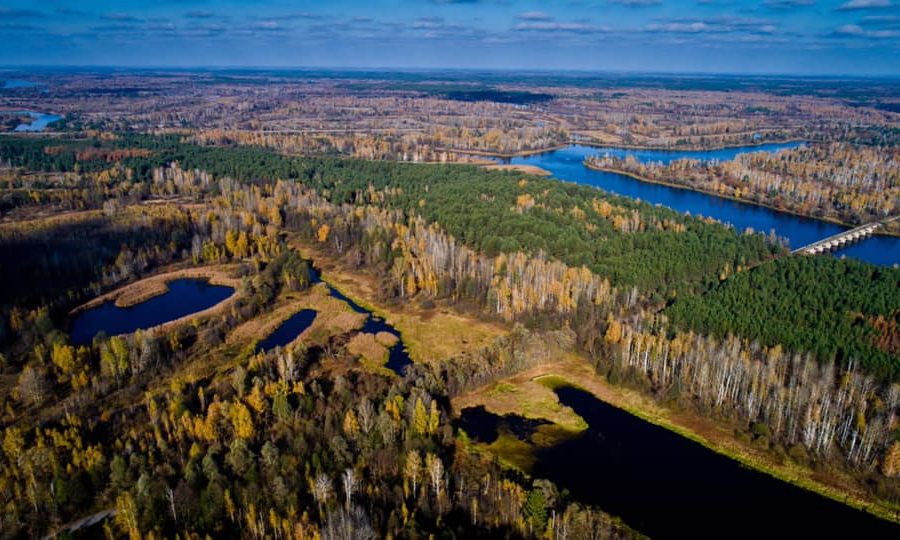A section outlining plans for the construction of the E40 waterway through the Ukrainian Chernobyl exclusion zone will be removed from the draft 2030 Exclusion Zone Development Strategy. This revision was announced by a representative of the State Agency for Exclusion Zone Management (SAZM) during an online meeting on February 11 2021. Attendees of the meeting were experts of relevant government agencies (such as the state specialised enterprises “Chornobyl Nuclear Power Plant” and “Ecocenter”) and the public.
Public review of draft development strategy
The 2021-2030 strategy for the development of the Exclusion Zone and the zone of unconditional (compulsory) resettlement that suffered from radioactive contamination due to the Chernobyl nuclear disaster is being developed in accordance with Presidential Decree № 512/2019. The strategy states the future aspects planned for the zone. In December 2020, the draft strategy was published for public consultation on the SAZM website. Many stakeholders provided comments including the Ukrainian Ministry of Environment, the State Inspectorate for Nuclear Regulation, the public councils at the Ministry of Ecology and Nature Resources of Ukraine, and several NGOs such as Save Polesia partners – National Ecological Center of Ukraine (NECU) and the Ukrainian Society for the Protection of Birds (USPB), among others.
Concerns that draft strategy paves the way for the E40 waterway
Several organisations raised concerns over section 5.9, “Development of transport infrastructure”, of the draft strategy arguing that the plans are unacceptable:
“The mentioned section is entirely devoted to lobbying for the creation of an ecologically dangerous and economically unreasonable project of the international E40 waterway. This project has not undergone a Strategic Environmental Assessment, an Environmental Impact Assessment nor an Espoo Assessment. For these clear reasons, it cannot be included in the strategy, “says Oleg Dudkin, Director of USPB.
The proposed E40 waterway would turn the Pripyat, one of Europe’s last untouched rivers, into a shipping canal. This would require massive dredging, expanding and straightening. The extent would be far beyond the existing main channel. The project’s proponents seem not to be familiar with the situation in this area. According to one of the meeting’s attendees – Sergei Kireev, Director General of SSE “Ecocenter” – the floodplain of the Pripyat river is one of the most polluted areas. He says that today, the leaching of radioactive elements from the river floodplain is only prevented due to water protection complexes created shortly after the Chernobyl accident. The E40 waterway project does not provide any information on how its construction may affect the existing water protection structures. This justifies and even enhances public concerns.
“The promise to remove the E40 waterway from the 2030 strategy is good, but we want to see the revised text of the document. This is not publicly available yet, even though a strategy is really needed. Only afterwards could we move on and conduct a Strategic Environmental Assessment of the plans in accordance with the law, ” says NECU expert Heorhiy Veremiychyk.
Following up on this commitment
On February 16, SAZM published a Statement on Determining the Scope of the Strategic Environmental Assessment (SEA) of the 2030 Exclusion Zone Development Strategy. Thus, the first stage of the SEA is already completed. The next stage will be to discuss the draft strategy itself. The Save Polesia coalition seeks to verify the final version of the strategy where the E40 waterway is removed.
Ukrainian State Agency for Exclusion Zone Management agrees to remove E40 waterway from their strategy. Revision announced after stakeholders, including #savePolesia partners, raised concerns over “Development of transport infrastructure” section of the draft strategy.
Tweet
Additional information:
- Visit our petition page and sign to call on governments to cease construction and properly assess the project
- Learn more about the threats from the E40 waterway and read our factsheet ‘Polesia under threat – How a new waterway could destroy Polesia’s natural environment’
- Find out more about Polesia and read our factsheet ‘About Polesia – A unique wilderness of global importance’
* Top image of the Chernobyl exclusion zone retrieved from the Facebook page of the State Agency for Exclusion Zone Management.

